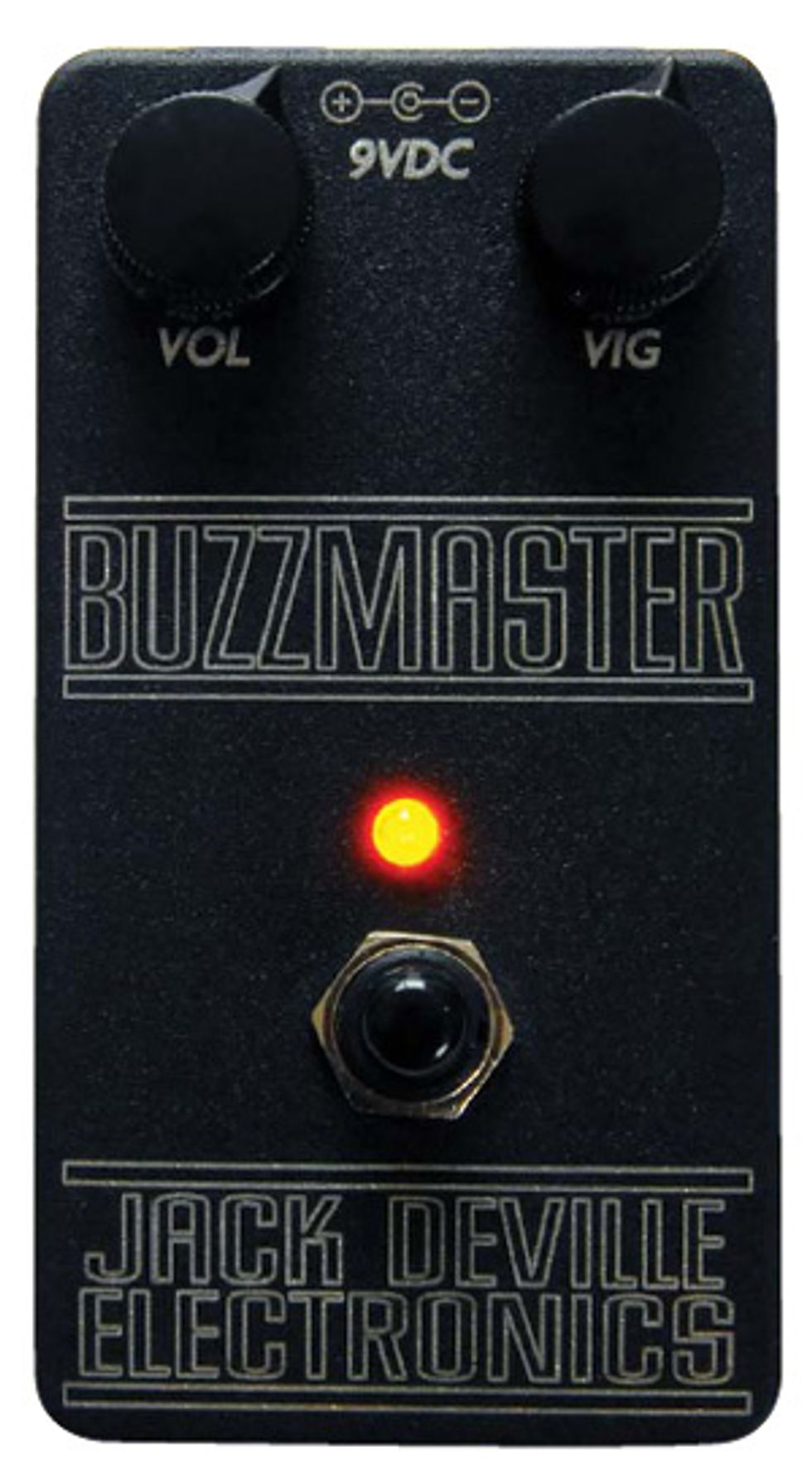A lot of fuzz flavors in one box
 | |
| Download Example 1 Volume: 10 o'clock, Vig: 2 o'clock | |
| Download Example 2 Volume: 3 o'clock, Vig 10 o'clock | |
| All tracks recorded with a humbucker-equipped Gibson Les Paul and a 1966 Fender Bassman. | |
The guitar-playing citizens of Portland, Oregon, may know Jack Deville
as the man who can fix their amp in a pinch. But elsewhere in the world,
this esteemed Northwest amp repairman is fast making a name for himself
as designer of two unique-sounding pedals, the Dark Echo delay
and the all-germanium Buzzmaster fuzz reviewed here.
All Business
The Buzzmaster’s bold, gold text and matte black box has a utilitarian,
let’s-get-down-the-biz-of-heavy-rocking look—something Lord Vader
would have in his rig, perhaps. The control set couldn’t be much simpler—
at least on the face of the pedal. There’s a Volume knob and a
gain labeled Vig, which is short for "vigor." The latter is appropriate,
given the pedal’s potential energy and range, but maybe not quite as
suggestive of the evil this dial can introduce to your tone. Inside the
casing, there’s a miniscule bias trim knob that helps you fine-tune the
pedal’s first stage and can assist in overcoming the inherent instability
of germanium transistors in varying climates.
The footswitch is a clickless, true-bypass switch of Deville’s design (you
can also buy it as an aftermarket product for retrofitting other boxes)
that eliminates popping—particularly at super high-gain settings—when
you kick the pedal on.
A Rangy Voice
For a pedal that looks so straightforward, the Buzzmaster has a very
complex personality. I got to know the Buzzmaster using a blackface
Fender Bassman driving a 2x12 cab, a 50-watt Ampeg SuperJet 1x12
combo, a Marshall 1987 Plexi, a Fender Jaguar, Rickenbacker 330, and a
Guild Starfire with DeArmond humbuckers.
With the Vig control rolled almost entirely off and the Volume kicked up
a bit past unity, the Buzzmaster was gritty, but not buzzingly overdriven.
It inhabited a bluesy territory, but a plot much more akin to Cream-era
Clapton making a Marshall sing than SRV and a Tube Screamer. Though
the Buzzmaster gave the Bassman a nasty, cutting quality on top of its rubbery
low-end signature—particularly with the semi-hollow Rickenbacker
and Guild—I sensed the pedal wasn’t quite in its comfort zone.
But with a twist of the gain knob, now set just short of noon, I felt
the Buzzmaster was working in the manner its creator intended.
The Jaguar’s neck and bridge pickup took on a nasty, nasally snarl
with detectable low-octave tones that flirted with octave fuzz territory
and sustained mightily with the help of some aggressive finger
vibrato. The harmonic spectrum was even wider when using the semi-hollowbodies.
The Rick’s top-end detail remained intact and floating
above the burly, low-mid growl and heavy low-octave traces that
offered more than a hint of vintage Univox Super Fuzz. The Guild’s
DeArmonds drove the Buzzmaster further into the ice pick zone on
high single-note lines, but with the same traces of low octave booty,
and first-position chords roared almost like a vintage Big Muff with a
dry, high-end bump.
The Buzzmaster can get delightfully unruly too. Maxing the gain knob
and dialing up the volume induced a very useful, killing-my-amp kind of
breakup where high end decayed chaotically over a bed of sustained
low-end grumble. And while it isn’t a setting that’s suited to sustained
Townshendian power chords, it works well for faster single-note picking,
enabling you to relay a lot of melodic data without too much mud.
The Verdict
The Buzzmaster packs a lot of fuzz flavors in a single box. Fans of vintage
Big Muffs, Super Fuzzes, and even the crispy, crackling sounds
of Mark I Tone Benders and old Maestros will find familiar and friendly
tones within. The biggest surprise, and perhaps the pedal’s strongest
point, is the heavy octave sound that emerges in the Buzzmaster’s fuzz
voice at high-gain settings. The pedal is likely to work best in front of a
clean amp (things can get hectic fast in front of hotter Marshall circuits).
But if you need the kind of fuzz that can punish with personality and cut
through any mix, the Buzzmaster is more than up to the task.
Buy if...
you like a bossy, multi-voiced fuzz.
Skip if...
you’ve begun to embrace subtlety in your ripping leads.
Rating...
Street $250 - Jack Deville Electronics - jackdeville.com |
| Tone Games 2010: 30 Stompboxes Reviewed | Next in DIRTIER: Stomp Under Foot Ram's Head |


